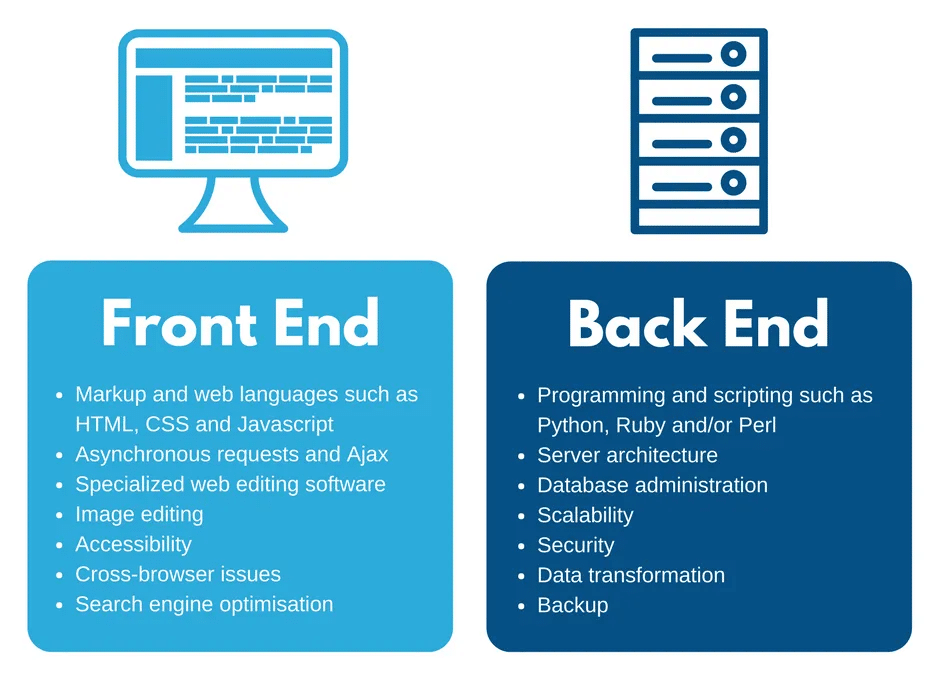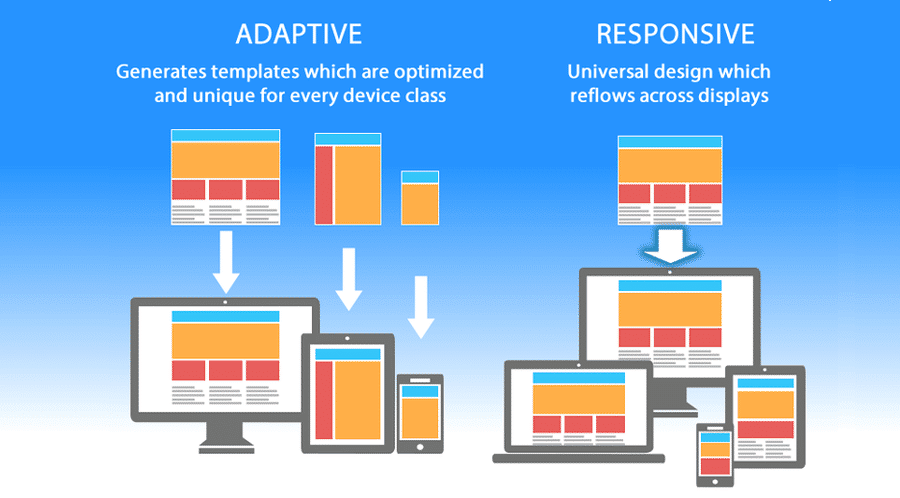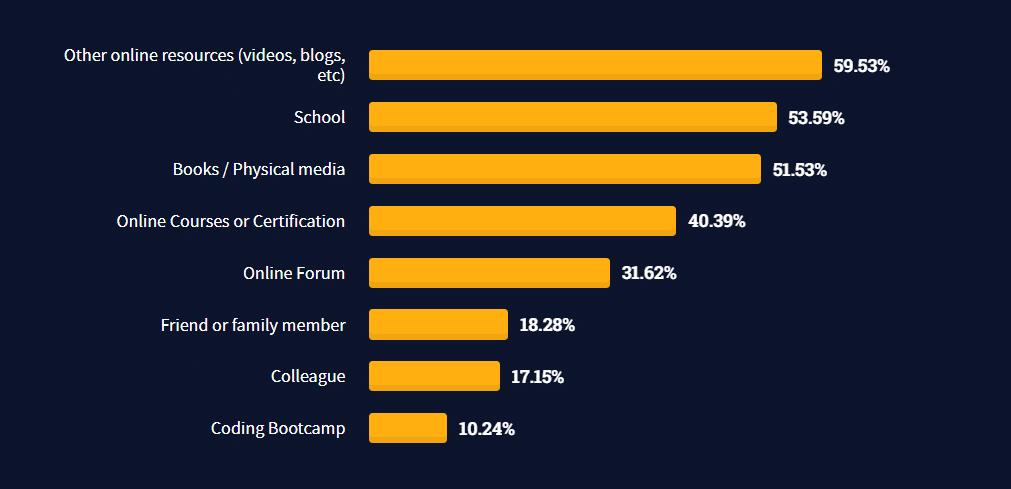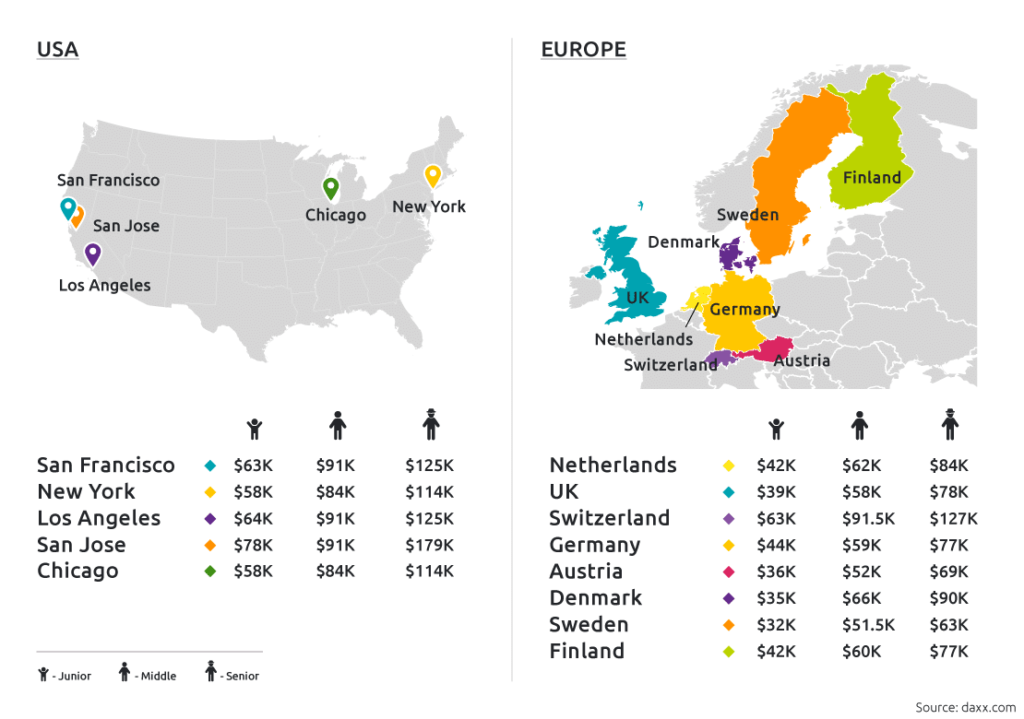Most of us interact with multiple websites and mobile apps every day. We click buttons, log in and out, and add products to our shopping carts without thinking about who makes it all possible.
But every time we interact with a website or application, we enjoy the work of a front-end development engineer.
This sounds like an amazing job. But is it worth becoming a front-end development engineer in 2022 ? And how do you even get started?
This article tells you what you need to know about front-end development engineer jobs, the skills they require, and how you can get the job.
Are you an employer looking to hire front-end development engineers? We cover that too.
What is a front-end development engineer?
Front-end developers use code to implement the design of a website or application.
Their primary tools are HTML, CSS, and JavaScript – HTML for the overall structure and content of the site, CSS for styling, and JavaScript for advanced interactions.
What is front-end development?
Front-end development refers to the development of a website’s user interface. Anything that users can view or interact with (such as layouts, images, menus, or login forms) is considered the front end of the website.
Another major type of website development is back-end development. Users don't see the backend developer's work, but it makes the website possible. The backend of a website includes servers, databases, backend logic, and APIs.

Front-end and back-end development ( Source: francescolelli.info )
You’ll also hear the term full-stack development. Full stack developers are generalists who develop both front-end and back-end.
What does a front-end development engineer do?
Front-end developers build and maintain the front-end of a website or application. Examples of parts of the website they work on include:
- Layout design
- Navigation function
- picture
- video
- button
- search bar
- log in page
- social media integration
What are the responsibilities of a front-end development engineer?
Front-end developers are responsible for building a website or application that provides a delightful user experience. This means it looks good and works the way it should.
Front-end developers are usually not responsible for the design of the website. However, they work closely with UI and UX designers to turn their ideas into reality.
Once a website or application is built, front-end developers are responsible for maintenance, testing, and ongoing development, such as feature upgrades.
What skills are needed to become a front-end development engineer?
Every front-end developer needs to be proficient in HTML, CSS, and JavaScript. These three languages are the basis for almost everything you do.
You'll need other skills as well, but the skill sets required will vary from job to job.
The list below covers some of the most common skills required for front-end development jobs. Learning as much as possible about these skills will make you the best candidate for a wide range of positions.
HTML and CSS
HTML and CSS complement each other and are the cornerstones of website design.
HTML is the abbreviation of Hypertext Markup Language. It defines the structure of a web page. For example, you'll use HTML to indicate the placement of headings, where to put a paragraph break, and where to insert an image. All the text and images you see on this web page are done in HTML.
CSS is the abbreviation of Cascading Style Sheets, which is responsible for handling styles. For example, CSS might specify a background color or font. You can use a single CSS stylesheet to style your entire website (that is, multiple pages at once).
A good front-end developer is experienced with HTML and CSS and can quickly understand how to use them together to create a design.
Fortunately, HTML and CSS are fairly easy to learn. But truly mastering them takes time.
Once you've mastered the basics, you can practice your coding skills by looking at existing websites and trying to clone the layout and functionality you see.
JavaScript
While HTML sets the frame and CSS defines the style, JavaScript makes a website interactive.
If a website is doing more than displaying static information, it's probably thanks to JavaScript. For example, you can use JavaScript to create a map that updates in real time, or to animate part of a website.
According to a StackOverflow survey, JavaScript is the most used programming language by professional web developers . The next most popular language is HTML/CSS.

Programming languages used by professional developers in the past year ( Source: insights.stackoverflow.com )
JavaScript is more complex than HTML or CSS, but is still one of the easier programming languages to master. Expect you to learn it within a few months.
React and other JavaScript libraries and frameworks
JavaScript libraries and frameworks are tools that make JavaScript development faster and easier.
A JavaScript library is a reusable set of code that you can put into your project. It saves you the trouble of developing a feature from scratch when another developer has already completed it.
There are currently over 83 libraries, each serving a specific purpose. For example, Chart.js is a library that allows you to easily create charts and graphs for your website.
One JavaScript library you should be familiar with is React. React is a free and open source library maintained by Facebook. It is used to build user interfaces for single-page applications and is currently the most popular JavaScript library.
JavaScript frameworks are similar to libraries. They both provide reusable code, but the usage is somewhat different.
When you use a library, you are responsible for the flow of the application. You decide where in your code to call components from the library.
When using a framework, you insert your code into the framework. Instead of your code calling the library, the framework calls your code at the specified location.
A few popular frameworks to become familiar with are Angular.js and Vue.js.
Node.js
Node.js is often mistakenly called a framework or programming language, but it is a runtime environment for front-end and back-end development.
Normally, the user's browser renders JavaScript. Node.js lets you run your JavaScript code outside of the browser.
Node.js is popular because it makes web development more efficient. It allows programmers to use a single programming language to create the front-end and back-end of an application.
You may have to use Node.js in your front-end development work, so it's something worth learning. You can download and install it yourself so you can practice.
Ajax
Ajax is the abbreviation of Asynchronous JavaScript and XML. Ajax itself is not a technology , but a set of programming techniques.
Ajax is about asynchronous development. This means you can update part of a webpage without reloading the entire page.
A classic example is autocomplete. When you start typing a search query into Google, the search engine offers you autocomplete options. It does this without reloading the entire search results page.
Many front-end development jobs require familiarity with Ajax concepts. Once you've mastered JavaScript, online tutorials can teach you how to use it with Ajax.
Other programming languages
Depending on the project you're working on, you may want to know about other programming languages besides JavaScript .
For example, TypeScript is an increasingly popular programming language developed by Microsoft. Typescript is a superset of JavaScript. Unlike JavaScript, it is designed for creating enterprise-level applications.
JavaScript is a must-know language, but once you get comfortable with it, you can explore other possibilities, such as:
- Typescript
- Elm
- Flow
- Dart
- Purescript
Knowing a programming language or two other than JavaScript can make you stand out among job seekers.
Bootstrap
We've already talked about JavaScript frameworks and libraries.
CSS also uses frames. The most important one is Bootstrap.
Bootstrap is a free collection of reusable code written in HTML, CSS, and (optionally) JavaScript. It allows developers to quickly build fully mobile-responsive websites.
As a front-end developer, it helps to have at least basic knowledge of Bootstrap. There are many online courses and tutorials, but don’t jump in until you have a strong understanding of HTML and CSS.
Content Management System (CMS)
A content management system is software that helps users create, edit, and manage website content without requiring technical skills.
For example, you can type up a blog post and add it to your website without having to worry about the HTML and CSS used to display the post.
WordPress is by far the most popular content management system. Others you'll encounter include Drupal, Joomla! and Ghost.
As a front-end development engineer, you will often work on websites using CMS. Working knowledge of these platforms is a marketable skill.
You can also do some work and create a new theme for WordPress or other content management systems.
RESTful services and APIs
An API (Application Programming Interface) allows one application or service to access resources within another application or service.
For example, a developer might want to integrate weather data into their website. They can use an API to contact the weather service and get the data.
RESTful API is an API that conforms to the constraints of REST (Representational State Transfer) architectural style and allows connection to RESTful web services.
As a front-end developer, you don't need to write your API for others to call (that's the back-end job), but you should know how to call the API and display it meaningfully on your website.
Mobile responsive design
Today, website visitors use a wide variety of browsers and devices.
When mobile devices account for 54.8% of global website traffic , it’s not enough for a website to look good on a laptop screen.
Some websites will have separate desktop and mobile versions, but more often, you'll want to build your site to be mobile responsive .
Responsive websites are designed to render well on any device, window or screen size.

Mobile Adaptive vs. Mobile Responsive Design
Whether a website is mobile responsive or not is important. 45% of consumers will abandon any content that does not display well on the device they are using.
Since there are no websites that don’t need to work on mobile devices anymore, understanding the principles of responsive design is a skill that a front-end developer cannot ignore.
Responsive design is done through HTML and CSS. It’s not intuitive, but there are many online courses and resources you can take advantage of.
Cross-browser testing and development
A website needs to look good and operate correctly on any browser. While Chrome is the most popular browser, developers shouldn't overlook Safari, Edge, or Firefox.
As a front-end developer, part of your job is to make sure your work looks good on any major browser. This means understanding the differences between browsers and testing your designs on them.
You can read about cross-platform development on popular coding resource sites. You should also practice. When working on your own projects, don't neglect testing on multiple browsers.
There are also tools that can help you with cross-browser testing. A few with free versions include:
version control system
A version control system can help you keep track of changes made to your website code. If something goes wrong, you can use them to revert to an earlier version of the code.
This can save a lot of time in the event of an error. Instead of finding the problem and manually undoing it, you can roll back the project to an earlier version.
Version control systems are also essential for collaboration. They allow multiple users to work on the same project without conflicting versions.
Git is the most popular version control management system, and it is required for many development tasks, whether it is front-end, back-end, or full stack. Get started by installing Git and creating an account on GitHub.com .
How to become a front-end development engineer
The most important qualification to become a front-end development engineer is proficiency in HTML, CSS, JavaScript, and some of the other skills listed above. Without coding skills, nothing else on your resume matters.
Today, it is possible to teach yourself to code using online resources.
40.39% of web developers currently take online coding courses, 31.62% learn from online forums, and 59.53% use other online resources such as blogs or videos.
To learn web development, check out these websites:

Where are current developers learning to code ( Source: insights.stackover.com )
It's possible to teach yourself to code, but that doesn't mean your formal education isn't important. Many front-end development jobs like and even require you to have a related degree. If you don’t have one, you’ll have to make sure your web development portfolio speaks for itself.
So, how do you create a portfolio if you have no work experience?
One way to show off your front-end development skills is to build websites and applications independently. Create a tool related to your interests, or see if anyone you know needs development work.
Is there a high demand for front-end development engineers?
Becoming a web developer is a great career move. We can expect to see 8% job growth over the next decade . This means there are approximately 13,400 job openings each year – much faster than the average occupation’s growth.
Both front-end and back-end developers are in demand, but there are slightly more openings for front-end developers. On Indeed.com, there are currently 14,600 open front-end development jobs in the United States, while there are 12,300 positions for back-end development.
What is the average salary of a front-end development engineer?
According to Glassdoor, the average salary for a front-end development engineer is $86,088 .
However, that's not the whole story.
Web developer salaries can vary greatly, depending on the type of company, the skills required for the job, your location, and your experience level. If you stick with it for many years, you can expect to earn a higher salary. The average salary for someone with the title of Senior Front-End Development Engineer is $107,276.

Front-end development engineer salary by region ( Source: daxx.com )
What should you pay attention to when hiring a front-end development engineer?
There are many website developers out there, but the truly talented ones are hard to find.
Here’s what to look for when hiring a front-end developer.
Technical skills
Every front-end development job is different. Go into the hiring process and learn the exact mix of skills you're looking for.
That said, web development is an ever-changing field. If you're going to work with this developer long-term, their commitment to learning new skills is even more important than their current skill set.
You can test candidates’ technical abilities by giving them a short coding test. If they do a good job, assigning a small (paid) test project can also be helpful. Use it to evaluate their attention to detail, the creativity of their solutions, and how well they communicate with team members.
other skills
In addition to coding skills, a good front-end development engineer also understands the importance of user experience.
Front-end development engineers create the website elements that users interact with. They are not UX designers per se, but a good front-end development engineer knows how to provide a positive experience for website visitors.
Your front-end development engineer should also have strong people skills. They will collaborate with other team members and stakeholders and communicate effectively on projects.
summary
Becoming a front-end development engineer is a great career move.
This is a job you can teach yourself online, the potential salary is high, and your skills will be in demand for years to come.
The best way to become a front-end developer is to learn everything there is to know about HTML , CSS , JavaScript and related skills. You can do this through school or by studying on your own using online resources.
Are you learning front-end development now? Check out these 60 great web development tools .